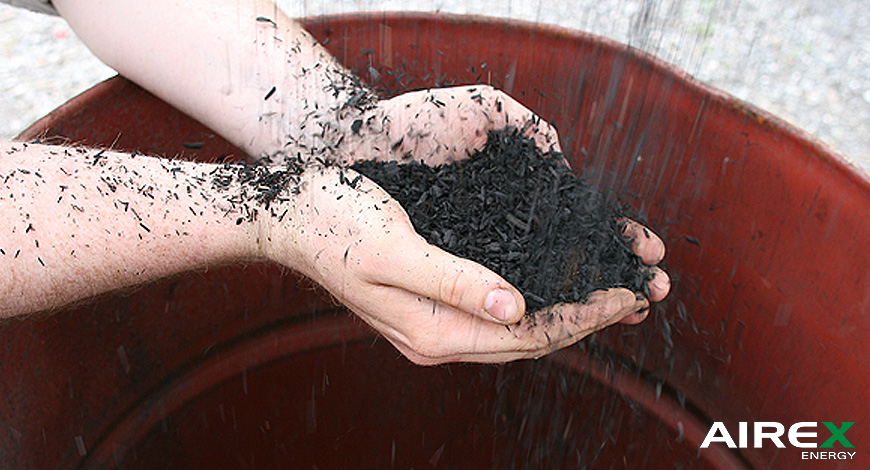
Biochar: A high value-added forest product
Is biochar production a key to the forestry bio-revolution?
Natural Resources Canada recently funded an innovative project that brought together the expertise of FPInnovations, Airex and Cyclofor. The objective was to find a way to enrich the forest biomass, a low-value raw material normally left behind on Québec’s tree harvest sites.A Optimized technology
Airex’s technology involves two phases. The initial conditioning phase occurs while the biomass is transported to the reactor. This phase increases the biomass temperature and lowers its moisture content. Results show that this step is important for obtaining various grades of charcoal. During the second phase, the material is transferred to a reactor where the biomass is converted into biochar. The conversion occurs at high temperature and lasts only a few seconds. Biogases, which are the gases emitted during the torrefaction, are continually routed to the burner where their combustion helps maintain an optimal process temperature. Airex’s technology is highly energy efficient, yet simple and robust, reducing the cost of producing biochar.Favourable context
The time is ripe for the research and development of biotechnologies based on forest biomass: energy costs are forecasted to rise, governments continue to want greenhouse gas reductions and the forestry sector is stagnating. Many jobs depend on the forest industry’s competitiveness and its ability to explore new markets and develop new products. These factors are fertile ground for developing technologies related to producing biochar. Both the high cost of harvesting and poor quality of forest biomass coming from harvest areas force research to focus on manufacturing high value commercial products. Gilles Brunette, Manager of the Composite Products department at FPInnovations, firmly believes that producing biochar from forest biomass will reduce fibre harvesting costs while diversifying the forest industry’s product line.Québec in a North American market
In the province of Québec, forestry operations on public land discharge 6.5 million tons of dry biomass yearly. A very small percentage of this forest biomass is harvested and most of it is transformed into pellets for energy production. According to Statistics Canada, Québec consumes annually some 2.5 billion litres of heavy fuel oil and 541,000 tons of coal. The high calorific value of biochar produced during the project combined with the rising prices of fossil energy allow to consider replacing these two sources of energy, which would reduce Québec’s GHG emissions by about 9 million tons. On another scale, the American industry sector could potentially use an estimated 900,000 tons of activated carbon, a high value-added biochar product, every year. When passed, currently proposed American legislation on GHG emissions would be a tremendous boon for activated carbon producers. Source : Jean-Luc Bernier, M.Sc., FPInnovations. «Innovation through Information», Canadian Biomass, March/April 2012, p. 11
Head Office
2500 Bernard-Lefebvre Street
Laval, Québec, Canada, H7C 0A5
450.661.6498
Bécancour Plant
103-4170 La Prade Blvd.
Bécancour, Québec, Canada, G9H 0B6
